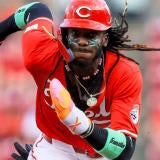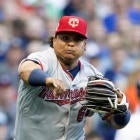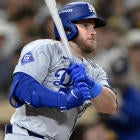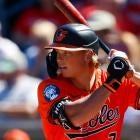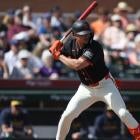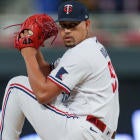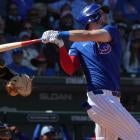Welcome to our 2019 Player Profiles series. We are going through the top-300 in Heath Cummings and Scott White's consensus rankings to give you the case for and the case against drafting each player. By the time you're done, you'll know everything you need to know for drafting in 2019.
Player Rankings: 1-10 | 11-20 | 21-30 | 31-40 | 41-50 | 51-60 | 61-70 | 71-80 | 81-90 | 91-100 | 101-110 | 111-120 | 121-130 | 131-140 | 141-150 | 151-160 | 161-170 | 171-180 | 181-190 | 191-200 | 201-210 | 211-220 | 221-230 | 231-240 | 241-250 | 251-260 | 261-270 | 271-280 | 281-290 | 291-300
291. Brandon Morrow, RP, Cubs
The Case For: Morrow has been a dynamite reliever over the past two seasons, posting elite run-prevention and strikeout numbers. When he's healthy, Morrow has given no reason to think he can't be one of the better closers in baseball.
The Case Against: The problem is, Morrow hasn't been healthy very often. And he won't be healthy by the time you draft him. Morrow started throwing in early February, putting him about a month behind schedule as he returns from an elbow injury, and you obviously must account for the chance that he's never right after getting a delayed start.
292. Shane Greene, RP, Tigers
The Case For: Even in a down 2018 season, Greene still racked up a healthy number of strikeouts, while cutting his walk rate to a career low. He's still got plenty of velocity to spare, and if he can get the home runs under control, there's no reason he couldn't return to his 2017 levels.
The Case Against: The pessimistic view is easy to explain: Greene had never really been good before 2017. When you talk about his career, that's the outlier, as he posted an uncharacteristically high strand rate. There are certainly some promising signs, but it's a long shot that he'll ever get back to 2017.
293. Luis Urias, 2B, Padres
The Case For: Urias' cup of coffee didn't go as hoped, but as long as he's healthy, he makes for a fine sleeper candidate in 2019. Urias consistently hit for high averages with great contact abilities in the minors and started showing enough pop in Triple-A that you could squint and see him developing into at least an average power hitter. Combined with his plus contact skills in an improving Padres' lineup, the potential for a healthy four-category stat line is easy to see.
The Case Against: The hamstring injury that ended his season in early September also lingered through the offseason. He is expected to be 100-percent healthy for spring training, but that stands as one red flag on his profile. Another was his extreme groundball approach in the minors, where he often ran up ground-ball rates over 60 percent. That issue followed him in his (exceedingly brief) time in the minors. He'll have to hit for at least some pop to be more than an empty average Fantasy also-ran.
294. Willians Astudillo, C, Twins
The Case For: If you don't know about Willians Astudillo, I highly recommend you go look up some photos and videos before finishing this. He is a one-of-a-kind player, who typically puts the ball in play on 90-95 percent of his plate appearances, allowing him to consistently run up batting averages in the .300 range, with burgeoning power. Give how rarely he strikes out, Astudillo is a strong bet to hit for a good average, and his average exit velocity was better than you might think last year. This is a Fantasy viable profile.
The Case Against: The problem? MLB doesn't seem to agree. Astudillo is an oddity, and baseball teams tend not to know what to do with those. He bounced around between four different organizations over the past four years, despite producing well whenever he got the chance. If he gets anything close to regular playing time, Astudillo has a pretty good chance to be a top-10 catcher, but it doesn't look like the Twins are even going to break camp with him. What a shame.
295. Carson Kelly, C, Cardinals
The Case For: Kelly has been a top prospect for years and would have had a chance at an everyday job long ego if not for the franchise legend blocking him in St. Louis. He's in Arizona now, with no competition for playing time. He's going to play as much as he can handle, and with a history of plus plate discipline and decent pop, he has the chance to be a must-start catcher in the reserve rounds.
The Case Against: How much of Kelly's struggles in his limited MLB sample are just the result inconsistent playing time? Kelly has hit well enough at Triple-A to justify his standing as a prospect worth taking a chance on, but he just hasn't been able to hit the ball with any authority in the majors. Playing in a Chase Field with the humidor isn't going to help if he can't start hitting the ball harder.
296. Mitch Garver, C, Twins
The Case For: He was a league-average bat in his first real taste of major-league playing time. You can do worse than that as your No. 2 catcher, even if the upside isn't considerable.
The Case Against: Garver may be the No. 2 catcher on his own team -- and Astudillo might be better as a backup catcher/utility option, to boot. Playing time may be too scarce to make him Fantasy relevant, given that he doesn't stand out in any way.
297. Nick Senzel, 2B, Reds
The Case For: One of the best prospects in baseball, we probably should have seen Senzel a lot earlier than 2019. The 2018 season went off the rails for Senzel with a bout of vertigo and then a season ending finger injury, but he was hitting .310/.379/.509 in 44 games, while picking up playing time in second base, third base, and shortstop. Now, the Reds will give him a chance to win an everyday job as a center fielder. They want him to play somewhere, and once he's in the lineup, he looks like a difference-maker from Day 1.
The Case Against: It seems unlikely Senzel will win a starting job out of spring training at a position he has yet to log a single inning at as a professional, and there isn't a spot for him to play along the infield barring a trade or injury. If the center field experiment goes well, maybe we see him in May; if not, there's a chance he is facing a Kyle Tucker situation and never makes it to the majors for an everyday job at all. That would be a shame, but it's not an unrealistic outcome.
298. Kevin Gausman, SP, Braves
The Case For: The Braves figured out how to solve some of Gausman's most pressing issues following a trade, as he put up a 2.87 ERA and 3.78 FIP in 10 starts to close out the season. He threw his slider less and his splitter more than ever, a good combination considering the splitter is by far Gausman's most effective pitch. He didn't pick up many strikeouts following the trade, but he managed to limit damage on fly balls, consistently his biggest issue. He was a different pitcher, but possibly a better one.
The Case Against: But probably not. Gausman sported a 4.56 SIERA after the trade, the worst of his career. His FIP was superficially low mostly due to an unsustainably-low HR/FB rate, one that probably can't be attributed to much more than good luck. When that regresses, we're looking at the same Gausman as always; a talented pitcher who shows flashes, but not one you'll ever want to rely on.
299. Brandon Lowe, 2B, Rays
The Case For: We didn't see the best from Lowe in his MLB debut, but what we did see left plenty of room for optimism. He walked a decent amount, hit for power, and had the kind of batted-ball profile that portends good things. Overall, between the minors and majors, Lowe hit 28 homers and 37 doubles, with 10 stolen bases, and even a fraction of that would make him a viable Fantasy option at any position.
The Case Against: There was an awful lot of swing-and-miss in Lowe's game when he made it to the majors. A solid contact hitter in the minors, he had just a 64.5 percent contact rate when he swung, in line with the absolute worst in the game. He'll need to tighten that up a lot, or an Ian Happ-esque swoon is likely.
300. Dereck Rodriguez, SP, Giants
The Case For: If you don't get a lot of strikeouts, you generally want to get a lot of ground balls to make up for it. Rodriguez did neither, but he made it work in his rookie season. Or, rather, his ballpark made it work. The newly-minted Oracle Park is still one of the best places to pitch in the game, and Rodriguez has shown an ability to induce plenty of popups, which makes him a candidate to continue to outperform expectations. He's probably someone you'll want around when the Giants are at home.
The Case Against: He's probably not a very good pitcher, even if he can outperform his peripherals a bit more than expected thanks to his home park. Rodriguez had a 4.58 SIERA, so some heavy regression is coming, which makes Rodriguez just a streaming option at best.
Read More Player Rankings: 1-10 | 11-20 | 21-30 | 31-40 | 41-50 | 51-60 | 61-70 | 71-80 | 81-90 | 91-100 | 101-110 | 111-120 | 121-130 | 131-140 | 141-150 | 151-160 | 161-170 | 171-180 | 181-190 | 191-200 | 201-210 | 211-220 | 221-230 | 231-240 | 241-250 | 251-260 | 261-270 | 271-280 | 281-290 | 291-300
![[object Object] Logo](https://sportshub.cbsistatic.com/i/2020/04/22/e9ceb731-8b3f-4c60-98fe-090ab66a2997/screen-shot-2020-04-22-at-11-04-56-am.png)


